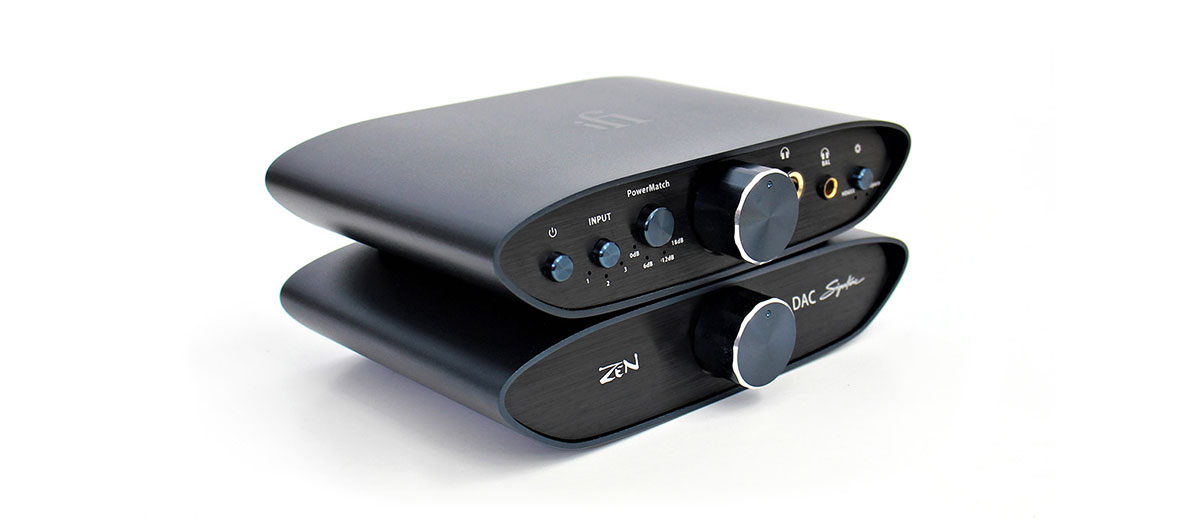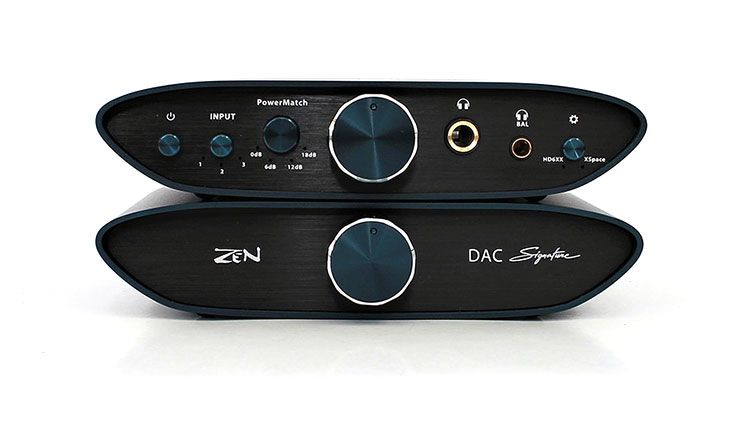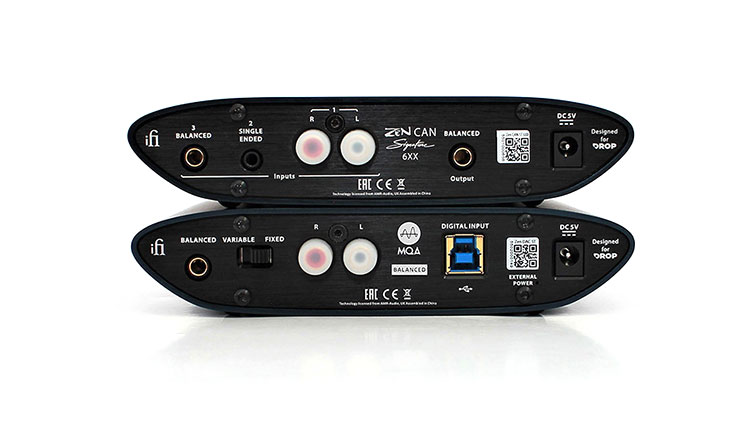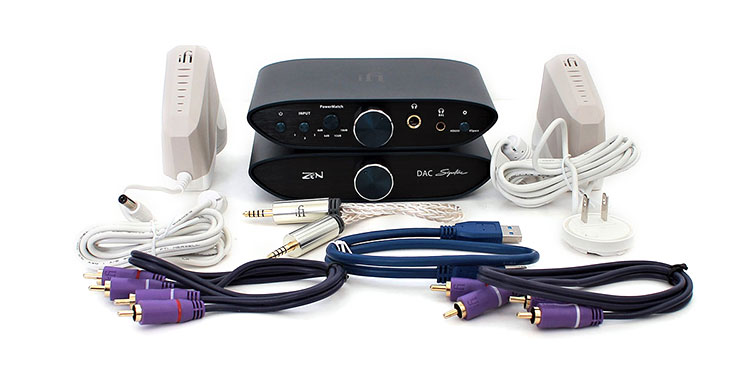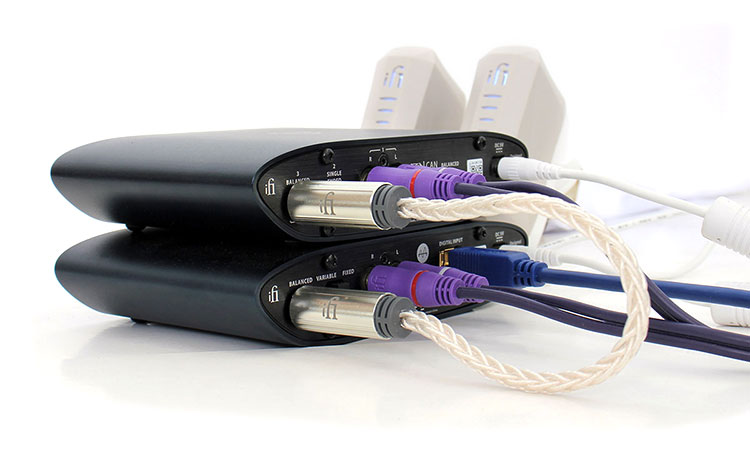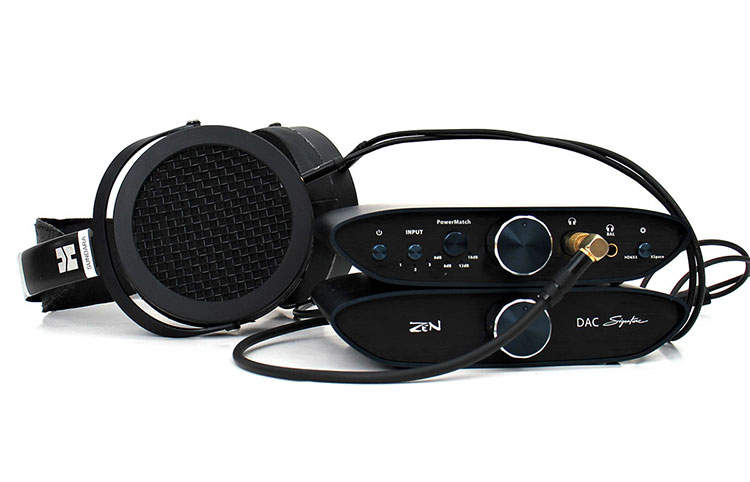iFi Audio ZEN Signature Set includes the ZEN DAC Signature V2, the ZEN CAN Signature 6XX, and a 4.4mm balanced cable. It is priced at $499.
Disclaimer: The iFi Audio ZEN Signature Set sent to us for the purposes of this review is a sample in exchange for our honest opinion. Thank you to iFi Audio for giving us this opportunity.
You can read more about iFi Audio products we reviewed on Headfonics by clicking here.
Note, this 2-page review follows our new scoring guidelines for 2021 which you can read up on here.
Take the iFi ZEN CAN series headphone amplifier, the iFi ZEN DAC Signature, pack in two iPower X power adapters with a 4.4mm to 4.4mm balanced cable, stuff them all in one box and you’ll get the general idea of what today’s review item is, the iFi ZEN Signature Set 6xx.
iFi makes all their gear from scratch and designs their own circuitry, and even writes up their own firmware so they decided to tweak a feature on their ZEN CAN to improve the sound of pair of Drop Sennheiser HD6xx which is one of Drop’s best selling headphones.
Every time I turn my head and back, iFi is releasing new gear. They like to introduce new designs and in their ideology conceptually like to improve over their product lineup. This box set is just that and at a reduced price to boot.
Tech Highlights
One of the major differences here is within the ZEN DAC Signature series component which I believe it’s the second iteration. If you remember version one had an Octa-core XMOS setup. I’m not talking about the first ZEN DAC with the headphone outputs but the standalone first version Signature DAC.
Most of the tech involved inside the ZEN DAC signature is borrowed tech from the iFi Pro line. For example, the controller used is the same double speed 2000 MIPS Hexadeca-core XMOS microcontroller off the Pro line. Memory has also quadrupled up to 512KB compared to the previous 8 core variant.
On the decoder end the Burr-Brown multi-bit chip used is also an improved chip inside the ZEN DAC signature which can do bit-perfect on PCM up to 32 bit 384kHz and native DSD up to DSD256. DXD is up and running plus full-MQA which is now decoded at the hardware level.
Not so much of an improvement but a tweak, the 6xx amplifier has a newly labeled button called HD6xx. The tweak involves attenuation of the 7kHz frequency and a gentle boost of frequencies below 500Hz. This tweak is equally applicable to the Sennheiser HD650 and of course the Drop version which is the HD6xx.
Design
No one else makes headphone gear in rounded trapezoidal shapes and is a unique Unmistakable iFi design. This iFi exclusive design this time around lost some of the past retro looks by a change in color scheme to a blue tint and white lettering.
The older variants with brushed aluminum looked more retro and this color scheme brings the components more in line with a modern-looking component.
The trapezoid shells are seamless and made of metal. Construction is hefty and holding each unit gives you a sense of rigidity and quality on a very high level. The metal shell also does a very good job of shielding against external interference. I actually put my phone directly on top of the units and heard no noise whatsoever.
There is one small particular improvement that might seem insignificant but I did notice it. The ZEN CAN and ZEN DAC buttons had a metallic rattle if you shook the unit but on this unit, that quirk has been improved and the buttons seem to be better padded now.
I/O
The ZEN DAC signature uses a single USB input which is a type B USB-C female connector. All the other connections are analog outputs. There’s a pair of standard L/R RCA outputs plus a 4.4mm Pentaconn balanced output. I did wish it had more input connectivity, perhaps an additional optical or a SPDIF input would have been nice.
The 6xx amplifier has 3 analog inputs which are rear-mounted; two are single-ended, the RCA and the 3.5mm input. The third input is a 4.4mm Pentaconn balanced input. The amp also has a 4.4mm Pentaconn output which can be used for dual or multiple amplifier setups.
Upfront, the DAC has no connections but the amplifier does. There are two connections on the front panel of the 6xx amp which are the 3.5mm single-ended and the 4.4mm Pentaconn balanced headphone output.
So we have one USB in, three analog inputs on the amplifier, daisy chain capability plus two headphone outputs which all together I think is more than adequate for most desktop setups.
Controls
Both units have slightly knurled and large volume knobs made of aluminum and mounted dead center upfront. There is a dot indicator to indicate at what position the volume levels are but I would have preferred the marks to be silver or white instead of the same blue as the button because they are somewhat too subtle and sometimes hard to see.
Both knobs are analog pots that operate smoothly but do commonly present volume imbalance at the lowest volume settings particularly but these were not that bad and only presented the particular issue with the most efficient IEMs and basically, none with the Power Match set to zero gain.
The DAC volume control output can be set to be fixed and bypass the volume control to have a constant output through the analog outputs. There is a switch on the rear panel for that which can set the output level as fixed or variable.
The 6xx amplifier volume control has no such feature but it does control the volume on the rear-mounted 4.4mm Pentaconn line output so the amplifier can fair well as a desktop preamplifier.
Packaging & Accessories
I had a rather unique experience with this setup because of the iPower X adapters that came in the box and you get two of them.
The experience happened the first night I went to bed, shut the light off, and saw the subtle 8k white glow behind the iFi logos emitting from these wall warts. Now all of a sudden I’m looking for a way to display these wall warts which is not normal of me.
These are the best-looking wall warts I’ve seen hands down and I really would like to set them up where they are visible. iFi promises cleaner sound by supplying ultra-clean power when these power adapters are used and I don’t doubt their words.
This might present a small issue for people who would install this combo in their bedroom and like to sleep in total darkness. If you install the setup in the living room for example then it’s not an issue but becomes a pro as they double duty up as subtle night lights.
Accessories
There’s an included 4.4mm to 4.4mm cable and it’s rather impressive looking and it even comes in its own box. The plugs are made with gold plated 4.4mm raised lip TRRRS plugs, the plug body is a thick chunk of aluminum iFi branded with short strain reliefs and linked up with OFC copper and silver matrix 8 core 14 AWG wire.
The rest of the accessories are more common fair and not as exotic. Two iFi blue colored RCA 3 foot cables and a 3 foot USB cable plus some literature also come in the box. A 3 foot USB wire is fine for laptop use but might be an issue for full-sized PC users because it might not be long enough to reach around enough.
Internal Hardware
The iFi Signature stack 6xx internal hardware list reads off as a list of some of the best components around without going the custom part route although the OV series OP-amps used are custom made by iFi.
Just to name some, Panasonic OS-CON ECPU film capacitors and ELNA Japanese capacitors are used inside both units. The ZEN CAN 6xx also uses some TDK capacitors.
The volume knobs are TOCOS multi-track analog potentiometers and although they were designed to minimize channel imbalance the manufacturer does recommend using them at above 11 O’clock but I found only the very bottom level had the issue so that setting is playing it very safe. The issue goes away a bit above the 8 O’clock position.
Performance Numbers
Have the specifications improved over the previous ZEN units? Signal to noise ratio on the amp stayed the same at 120dB. Jitter on the DAC side was improved by 20% by implemented improvements on the GMT Femto Precision Clock system.
What about power output? The listed balanced headphone out on the ZEN CAN 6xx is 1600mW max while the original ZEN CAN had its power out listed as a max of 1890mW at 64 ohms and 1600 at 32Ω.
However, looking at the specs again you could see the Signature 6xx can output 15.2 volts compared to the 15.1 max on the original version. So there might be a small improvement there in drivability but it’s minuscule.
Frequency response was expanded and I think the differences I’m hearing between the old and new models are because of the extra frequency extension. The listed frequency response of the original ZEN CAN for example was listed as 20Hz to 20kHz. The 6xx version has it listed as 10 to 200 Hz.
Wired Connectivity
USB-DAC
I read somewhere previously that you needed to exclusively use the volume knob on the DAC because once you input a source into the USB port on the iFi ZEN DAC signature the volume becomes fixed at the source and that is not the case here.
Both the NEO iDSD and the Diablo have a fixed output using the USB in and you have to use their volume knob but not with the ZEN DAC signature.
When I first connected my unit it did not ask for any drivers whatsoever and the unit worked as if it was a plug and play device at least on Windows 10. There is a driver available for download on the iFi website however it does give you more than a driver and includes a small app.
Buffer settings and steaming modes can be set within the small app and within the installed files themselves is another app which is for swapping out the firmware, all custom written by iFi. At the moment there are two available firmware versions for download.
Click on page 2 below for sound impressions and selected comparisons

